1994 Quarter Coin Value: How Much Is It Worth?
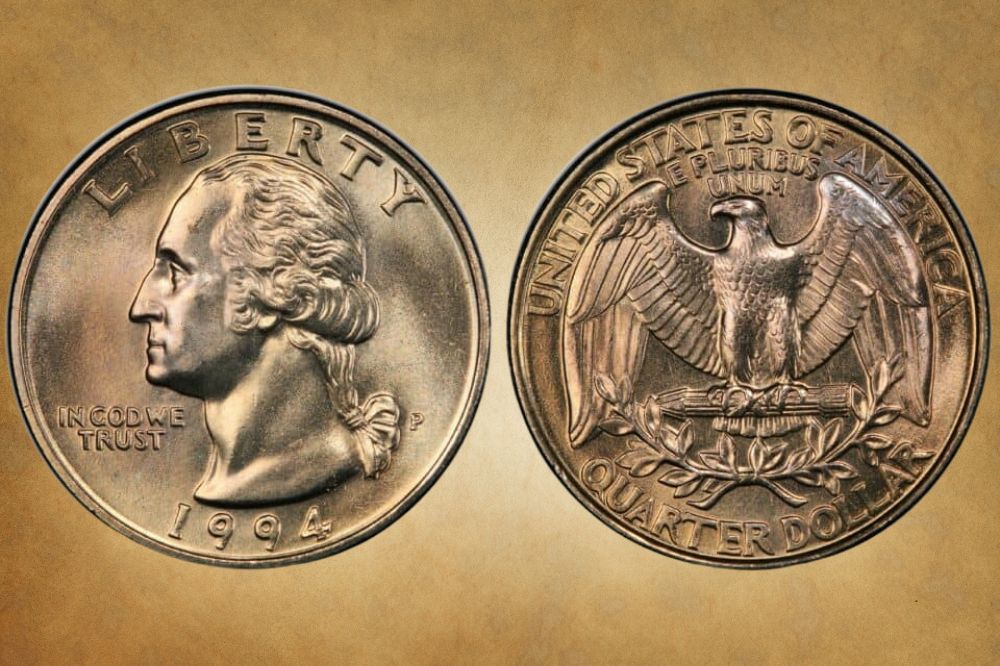
1994 wasn’t a key year for the Washington Quarter, but it has several mint mistakes. Those coinage errors increase the 1994 Quarter Value, even in low grades. And they make it a fun year for collectors because so many error coin varieties exist! Let’s look at a few examples.
1994 Business Strike Quarter Value Chart |
||||||||
Mint Mark |
MS 60 |
MS 62 |
MS 63 |
MS 64 |
MS 65 |
MS 66 |
MS 67 |
MS 67+ |
| 1994-P Quarter Value | $1 | $1 | $2 | $5 | $7 | $37 | $625 | $2,500 |
| 1994-D Quarter Value | $1 | $1 | $2 | $12 | $24 | $110 | $1,250 | $1,500 |
1994 Proof Quarter Value Chart |
||||||||
Mint Mark |
PR/PF 60 |
PR/PF 62 |
PR/PF 64 |
PR/PF 66 |
PR/PF 67 |
PR/PF 68 |
PR/PF 69 |
PR/PF 70 |
| 1994-S Clad Proof Quarter Value | $5 | $5 | $5 | $5 | $6 | $10 | $16 | $40 |
| 1994-S Silver Proof Quarter Value | $4 | $5 | $7 | $9 | $10 | $11 | $17 | $65 |
1994 Quarter Value Guide
Several factors dictate the value of a coin, including mint errors, rarity, and population. The most influential is condition or grade, which you can verify by sending your coin to a grading company like ANACS (American Numismatic Association Certification Service), NGC (Numismatic Guaranty Company), or ideally PCGS (Professional Coin Grading Service).
But all these grading companies use variants of the Sheldon Grading Scale that goes from 1 to 70. Coins are generally divided into collector’s coins and circulation coins. The circulating coins are called business strikes or regular strikes. As for collector’s coins, they include Proof Coins, Uncirculated Sets, Enhanced Circulated Sets, and Special Mint Sets sold to collectors.
Let’s talk about some of the grades you’ll see as we review the 1994 Quarter Value. Most high-value coins are MS for Mint State or AU for About Uncirculated. Proof Coins are graded PR by PCGS and PF by NGC while Special Mint Sets are graded SMS or SP. You sometimes see business strikes that seem like proofs, but they were not coined using proof techniques.
They’ll be graded PL for Proof-Like, DPL for Deep-Proof-Like, or DMPL for Deep-Mirror-Proof-Like. Damaged or altered coins are graded Details, Brilliant Uncirculated, Choice, or Gem. Lastly, you might spot an S, P, D, O, CC, etc. They confirm the branch of the US Mint that made the coin. The 1994 Quarter was struck in Philadelphia, Denver, and San Francisco.
1994-P Quarter Value
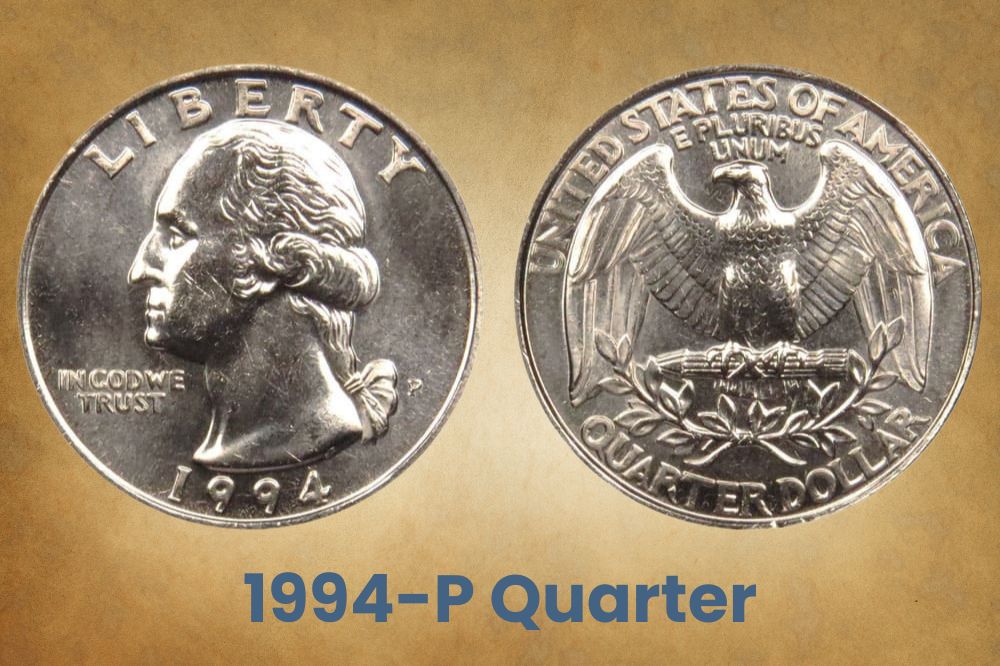
In 1994, the Philadelphia Mint made 825,600,000 Quarters with the P Mint Mark. In April 2006, an MS 63 sold for $864. Then in June 2019, a PCGS-graded MS 67 sold for $504. But two NGC-graded MS 67s only sold for $55 and $87 in August 2022. So far, the highest grade submitted to PCGS is MS 68. They’ve only received two. The estimated 2023 value is $4,000.
1994-D Quarter Value
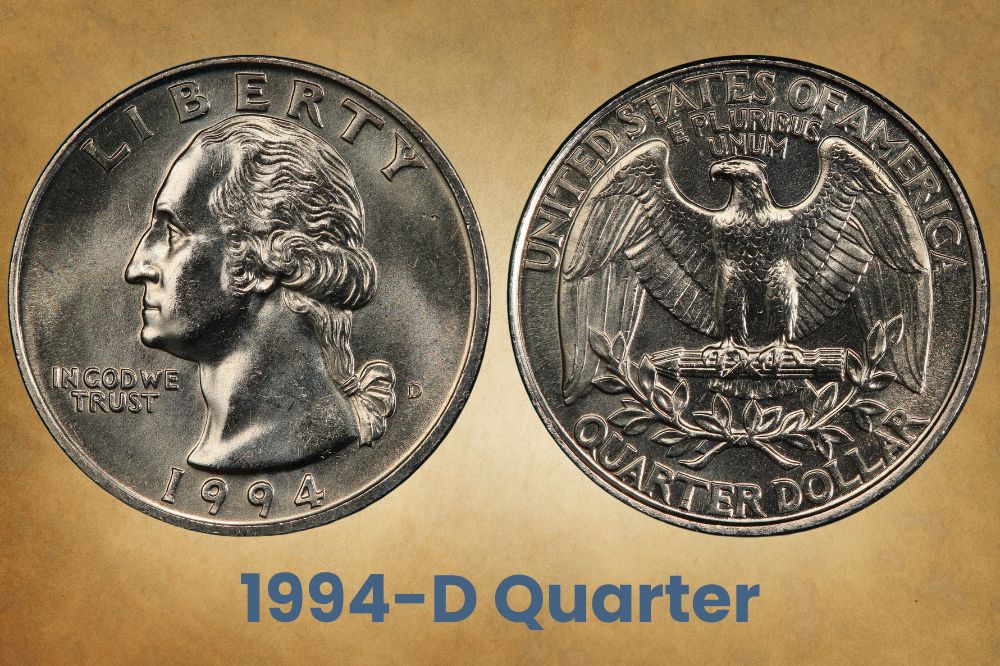
1994 saw 880,034,110 Quarters coined at the Denver Mint, all with the D Mint Mark. In February 2018, Heritage Auctions sold an MS 67 for $1,020. Then in June 2018, an MS 67 shot up a few hundred dollars, selling for $1,500 on eBay. But in June 2020, that was down to $840 at Stack’s Bowers. The highest coin graded by PCGS is MS 67+ estimated at $1,500.
1994-S Clad Proof Quarter Value
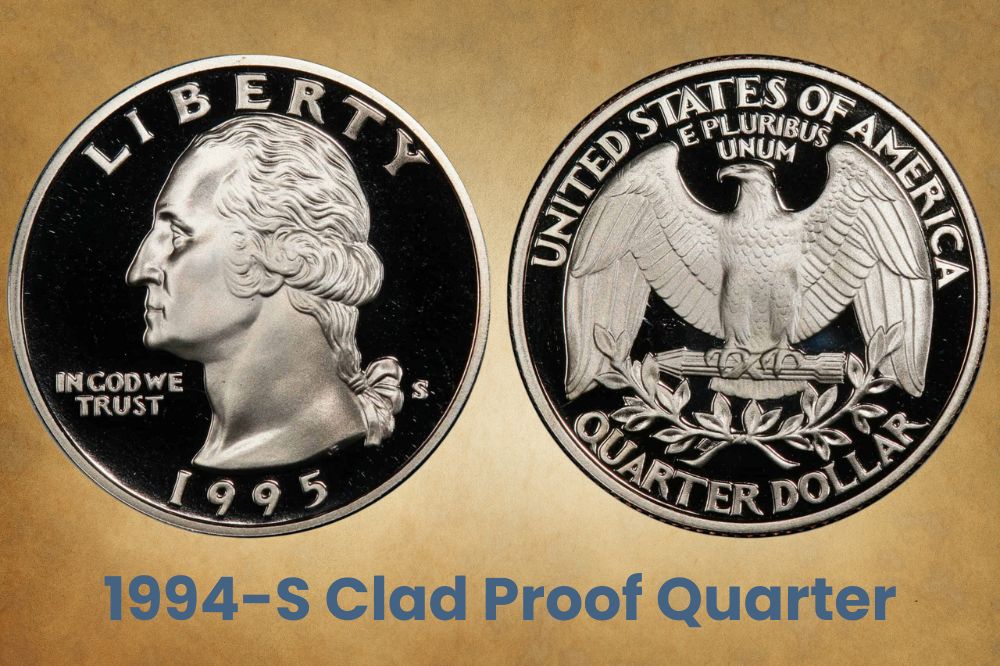
The San Francisco Mint made 2,484,594 Clad Proof Quarters in 1994 with the S Mint mark. They were mirror-like proofs, so they had mirror-like fields and frosted devices. Before 1970, this frosting was done by pickling the die in acid, but from 1971 onward, the hazy sections were done with a computerized laser. It’s far more durable than the prior acid-wash method.
That’s why earlier proof coins have varying levels of contrast between the die and the field, but newer proofs are almost always Deep Cameo (DCAM). NGC calls this grade Ultra Cameo. And in case you’re wondering how the coins get so shiny, the die is scrubbed with horsehair brushes and the planchets are burnished before striking by tumbling them in a special drum.
These burnishing vats have 6mm stainless steel balls or beads which shine the planchets by friction. The polished planchets are then rinsed before they’re loaded into the hopper and fed into the coin press for striking. In June 2004, a PR 70 DCAM sold for $308. In May 2020 that dropped to $19. Since PCGS has graded over 1,000 of them, the estimate is $40 in 2023.
1994-S Silver Proof Quarter Value
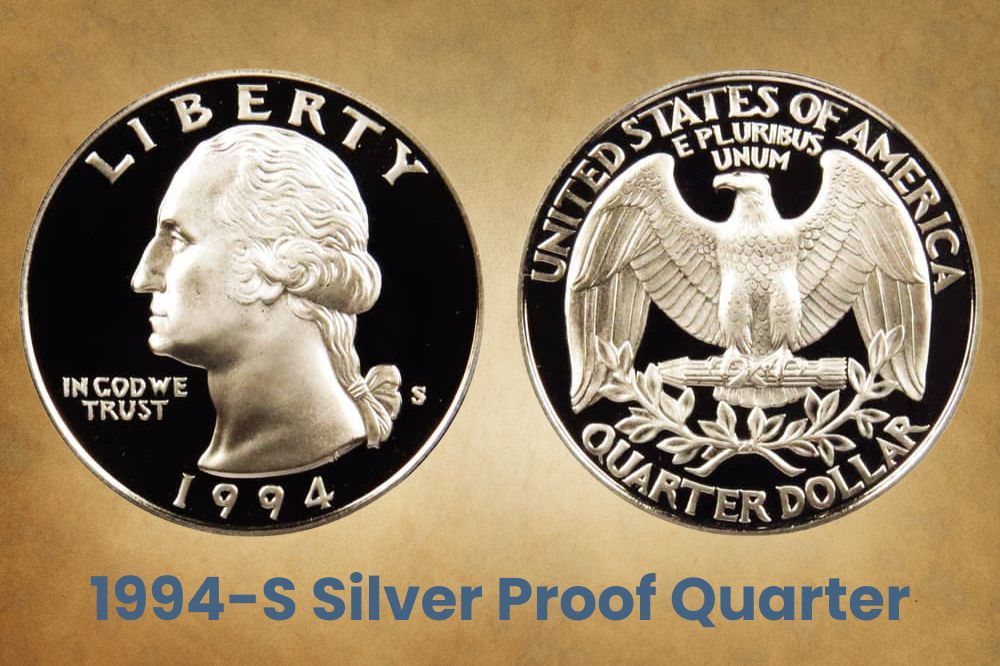
In 1994, the San Francisco Mint made 785,329 Silver Proof Quarters in addition to clad proof coins. They all had the S Mint Mark. In February 2007, a PR 70 DCAM sold for $863. By May 2020, that was down to $50. So far, PCGS has received almost 450 of these coins for grading so they estimate the coin’s value as $65 in 2023. It drops with every new submission.
Related Posts: 17 Most Valuable Modern Quarters Worth Money
1994 Quarter Errors
A coin with a mint mistake can often fetch higher prices than a flawed coin. These mistakes are less common on modern coins because most of the minting steps are automated with minimal human intervention. So errors like RPMs (re-punched mint marks) hardly pop up. But you can still get coins struck on the wrong planchet, and doubling occurs occasionally.
1994-P Quarter Struck on a Dime Planchet
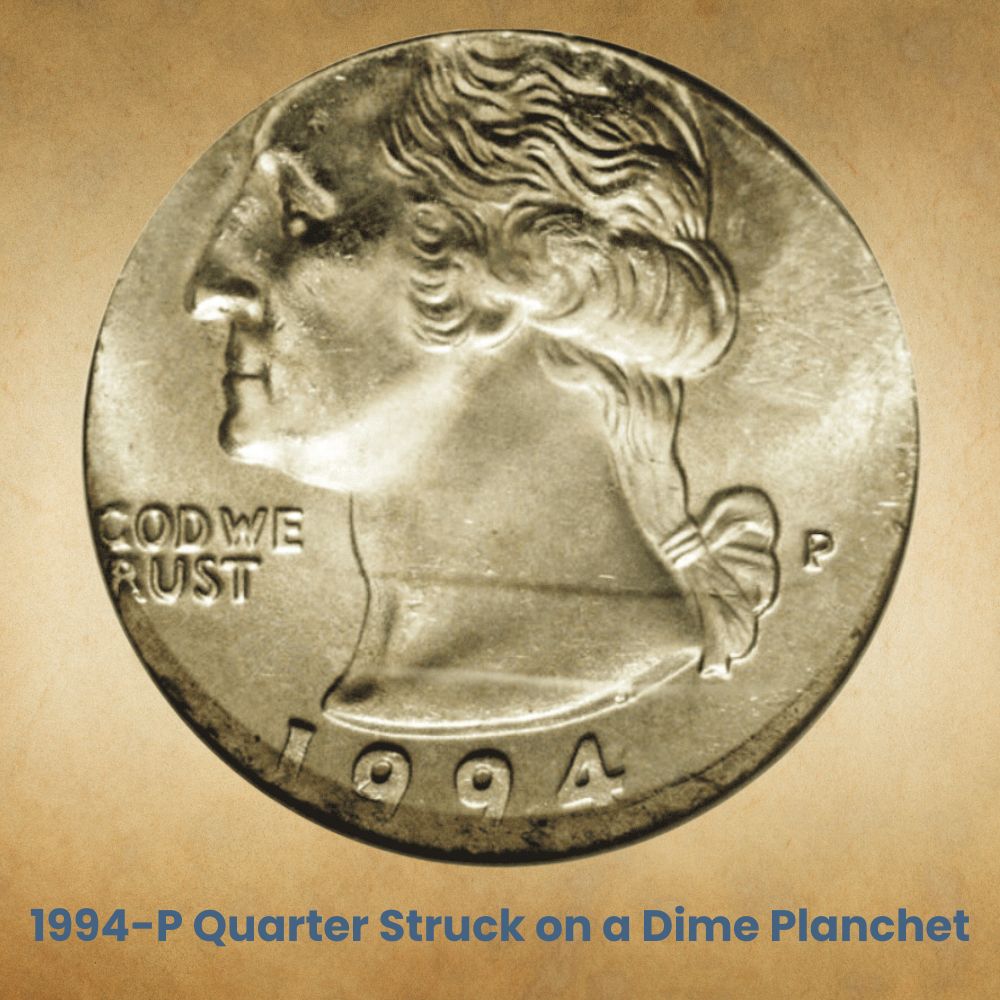
Planchets have different diameters, thicknesses, and metal compositions based on their face value. Sometimes, a coin gets struck on a blank that was intended for another denomination. Here, the 1994-P Quarter was struck on a 10c planchet. Dimes are smaller than quarters, so Liberty and Washington’s forehead got chopped off! It’s $400 in MS 62 and $840 in MS 63.
1994-D Quarter Reverse Clad Layer Missing
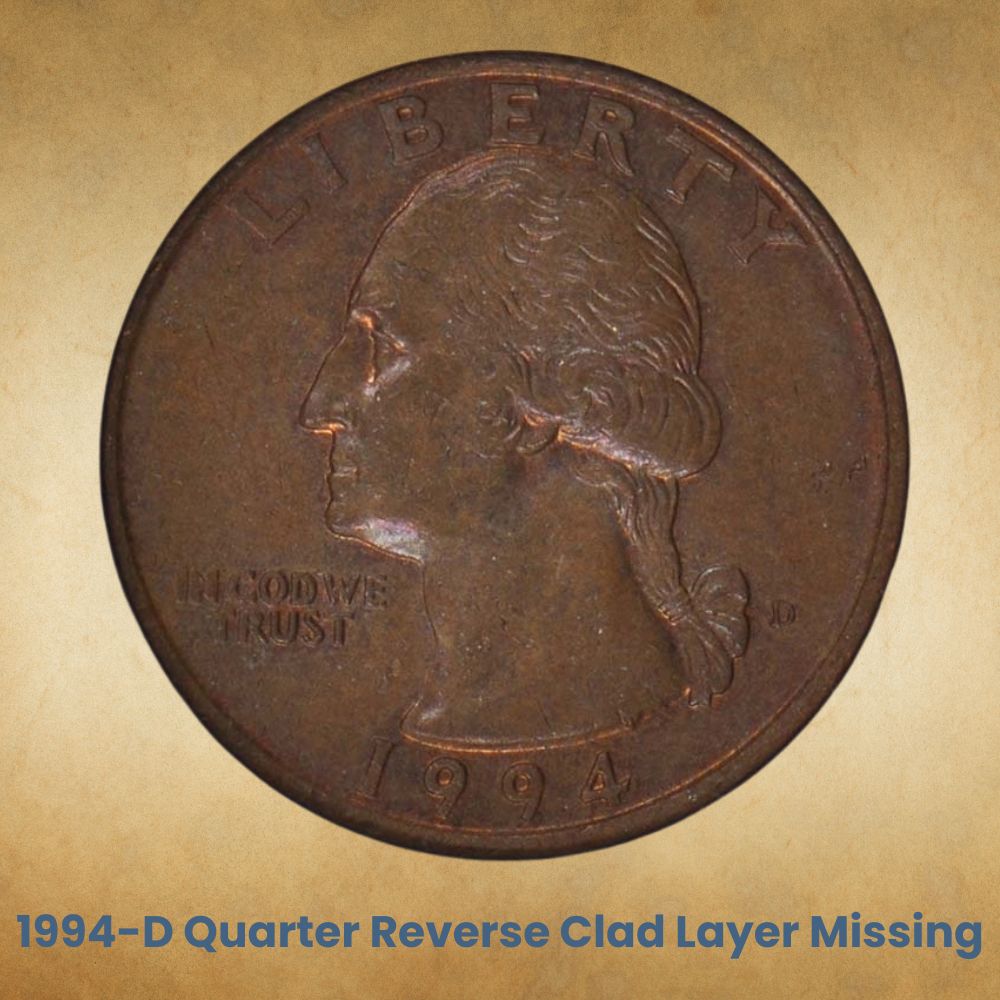
Quarters have a 100% copper core plated with a cupronickel layer of 75% copper and 25% nickel. But the metals don’t always blend. On this coin, the clad cupronickel layer is missing on the reverse of the coin, but the obverse looks normal and has all its layers. So the back of the coin has the color of a penny and the design of a quarter. In MS 64, it sold for $211.
1994 Quarter Matched Set aka Bonded Pair
Sometimes, an error occurs on two coins that followed each other through the coin press. It could be a die cap, where one coin got stuck on the die, blocking the next coin from getting struck fully and marring its design. Or two coins that overlapped in the coin press, multi-striking and deforming each other in the process. In MS 64 and 63, this pair was $1,610.
1994-P and 1994-D Quarter Curved Clips
Planchet sheets arrive at the mint in a massive coil that gets fed into the blanking machine to be flattened and punched into discs. The resulting metal is full of holes. But sometimes, the punch overlaps on a planchet that was already cut. It ends up with multiple clips instead of a perfectly circular shape. A 4-clip coin in MS 63 was $23 while a 3-clip coin in MS 63 was $18.
1994-P Quarter Double-Struck Error
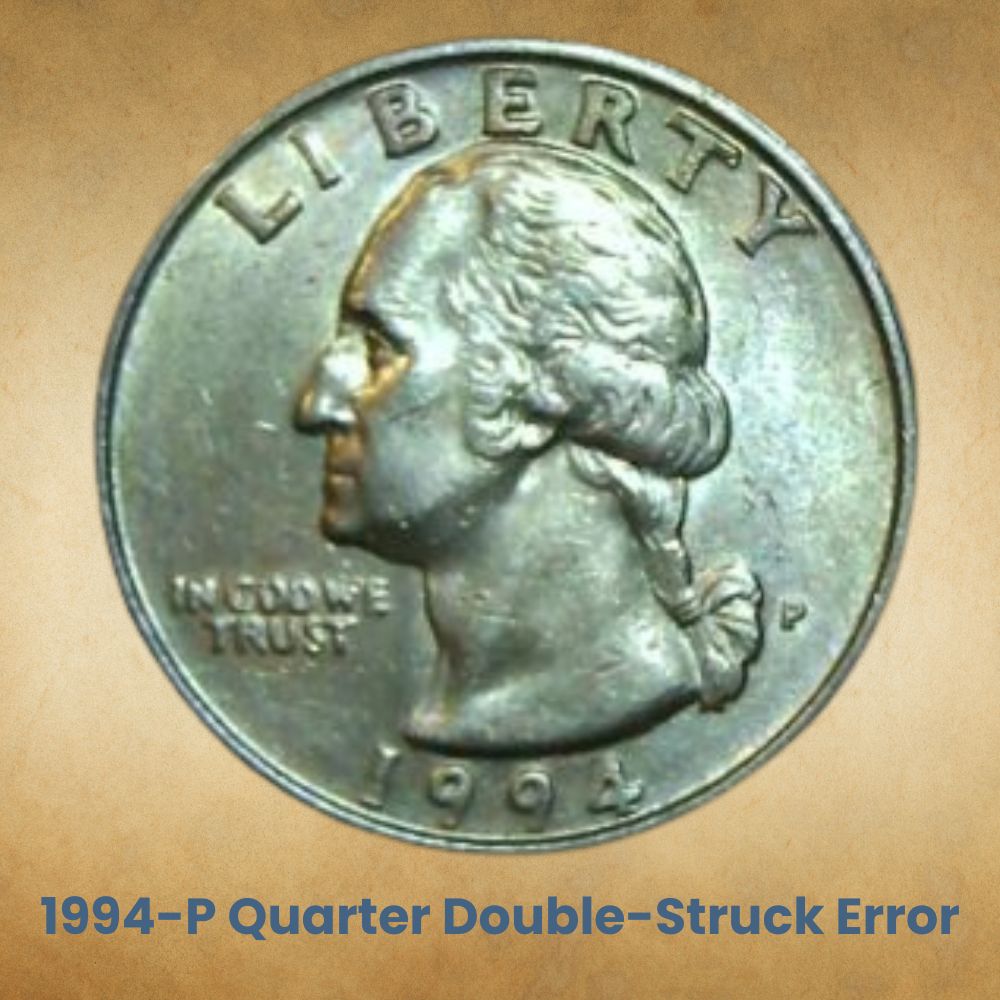
Coins are fed into and out of the press via automated feeder fingers. But on occasion, there’s a slight delay, meaning the next coin enters the mint before the previous one exited. The coin on its way out might then get double-struck, triple-struck, or multi-struck. It might also get a deformed shape from the extra strikes. This double-struck MS 61 Quarter was sold for $138.
1994-P Quarter Die Cap Error
We hinted at this error earlier, when a coin gets stuck on the die and obscures the next one. Both coins will end up with blank or blurry surfaces, but the coin that was stuck on the die is called a die cap error while the blocked one is called a brockage error. The brockage coin might have a mirror image since one die was covered. In MS 63, this die cap coin was $150.
1994-P Quarter Elliptical Clip Error
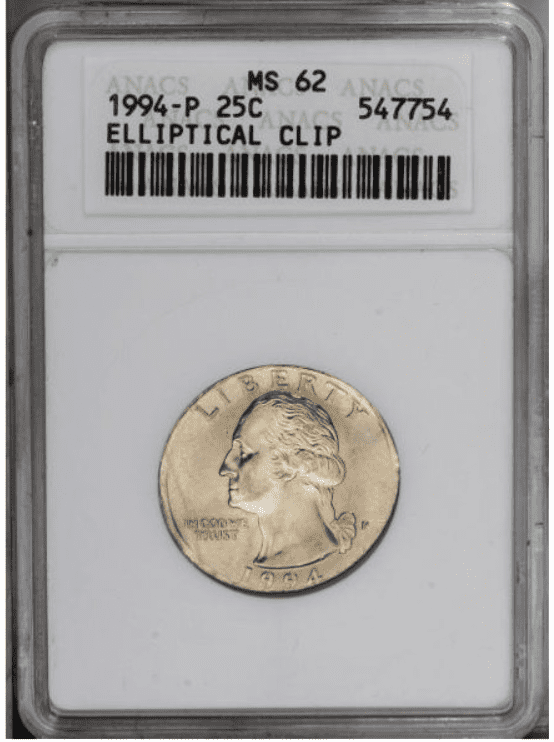
Here’s another example of an error from the blanking machine. This time, the planchet was punched into an elliptical shape instead of a circle. An ellipse is an oval or egg-shape, so the coin is deformed and won’t stack well. It’s not a drastic error though, so it might still slip into a coin bag and end up in your spare change. In MS 62, this misshapen coin was about $25.
1994-P Quarter Broadstruck Off-Centre
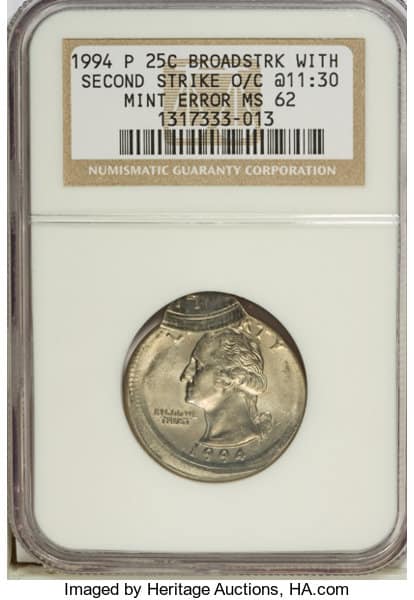
This coin has multiple errors. The planchet shifted before the first strike, so it has an off-center error that left a small part of the coin blank. Then the three-piece detachable collar mold fell off, causing the metal to slip outside its rim, which is called a broadstrike. On the way out, the coin was struck again, causing a double strike. In MS 62, it sold for over $125.
1994-D Quarter Obverse Clad Layer Missing
This mint mistake is similar to a coin we looked at earlier. Cupronickel planchets have pure copper in the middle with a 75:25 cupronickel layer on top and underneath. But as we said, the three layers don’t always fuse fully. While the previous error coin had no reverse plating, this one has its front clad layer missing. But it’s a cheaper coin that sold for $60 in MS 62.
1994-D Quarter Off-Centre Error
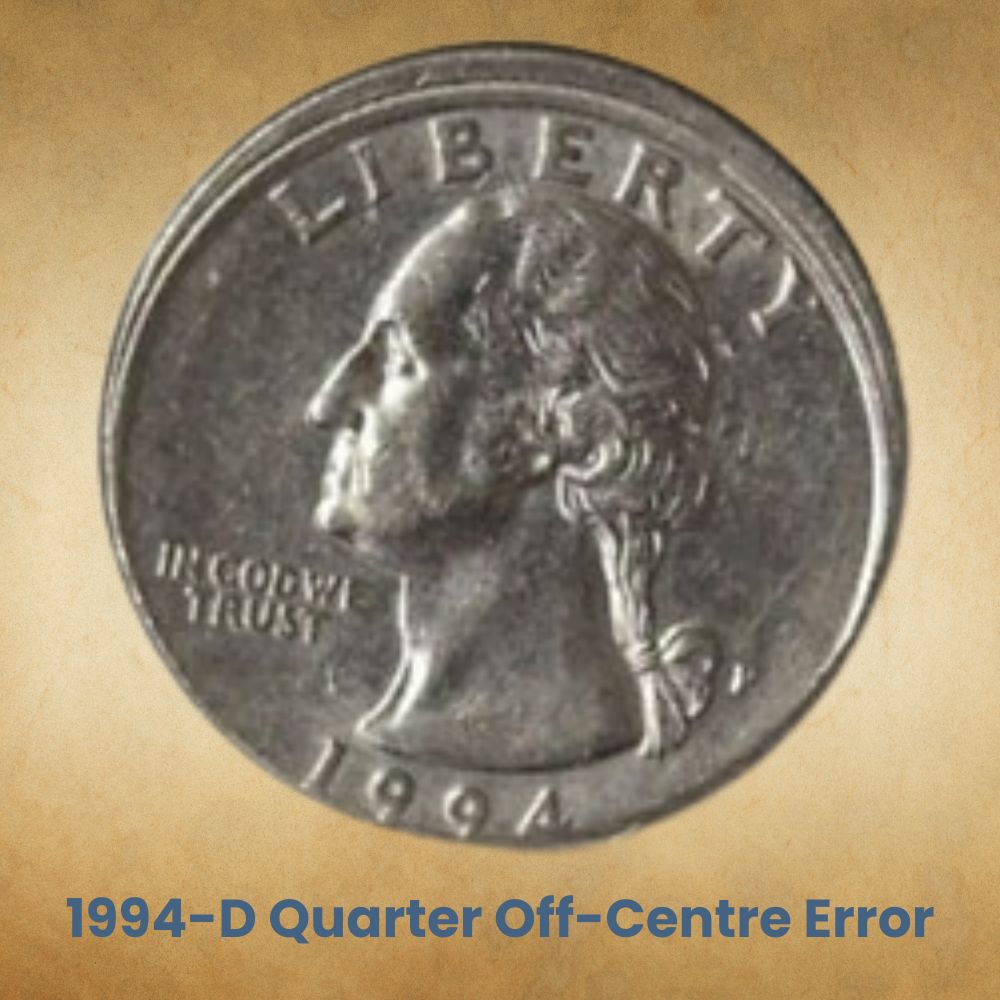
Most hubs, dies, and planchets have to be struck at least twice to ensure the details are correctly imprinted, and the target sometimes moves mid-strike. The type of error depends on when the target moved. If the planchet moved before the first strike, you get an off-center, so some parts of the coin will stay blank. The error is about $25 in AU 58 and $30 in MS 62.
Related Posts: 16 Most Valuable Quarter Errors
History of the 1994 Quarter
1994 is one of the final years of the original Washington Quarter. After 1999, the mint made a series of commemorative quarters, namely the 50 State Quarters (1999 to 2008), the DC and Territories Quarters (2009), the National Parks Quarters aka America the Beautiful (2010 to 2021), the Delaware (2021), and the American Women Quarters (2022 to 2025).
All these coins had George Washington on the heads side, using the portrait crafted by John Flanagan and later modified by William Cousins for the States and Territories Quarters. In 2022, they changed to a portrait by Laura Gardin Fraser. Curiously, Fraser’s design was way older – she sculpted it in 1931 and it was intended as the original design for this 25-cent coin.
Fraser was once a student of James Earle Fraser, the designer of the Buffalo Nickel. She later married him, and she had her own career as a respected sculptor. When the mint announced a competition to design a Washington coin (they initially wanted a Half Dollar but Congress pushed for a Quarter instead), Laura Gardin Fraser won. Sadly, someone disrupted things.
The Secretary of the Treasury, Andrew W. Mellon, ignored Ms. Fraser’s winning design and chose one by John Flanagan instead. Mellon’s reasons are unclear since he had used her designs before. Some say it was a gendered situation. Others say it was because Ms. Fraser had designed the Oregon Trail Memorial Half Dollar in 1926, and it didn’t sell successfully.
Either way, Flanagan’s coin was accepted by the mint and the public. It was evenly spread, well-centered, and had no high points, so it didn’t punish the dies the way that other artistic coins did. The design was so popular that – as we said – it wasn’t changed until 1999. Cousins shrunk it slightly to accommodate heavy rear designs on State Quarters. Let’s focus on 1994.
Related Posts: Top 10 Most Valuable Bicentennial Quarters Worth Money
how to identify 1994 Quarter?
If you’re new to coin collecting, some of the technical terms might befuddle you. So we’ll begin by reviewing the basics. People who study and collect coins are called numismatists. The coins themselves are struck on blank discs called planchets, and striking is the process of hitting a blank to imprint coin designs. Most coins, dies, and hubs require multiple strikes.
For reference, the hub is the steel template that makes steel dies and these dies eventually strike planchets to make coins. The front or heads side of a coin is called the obverse and the back or tails side is called the reverse. The thinnest sides are called edges. They sometimes have ridges called reeds, but if they don’t have reeds, they’re described as smooth or plain.
Coins are made by striking the planchet in a machine called a coin press. The images struck on a coin are called devices while the words are called legends or mottos. Most coins will also have a mint date to show the year, and sometimes a mint mark to show its coining location. To maintain that perfectly rounded shape, coins have a raised border called a rim or collar.
The Obverse of the 1994 Quarter
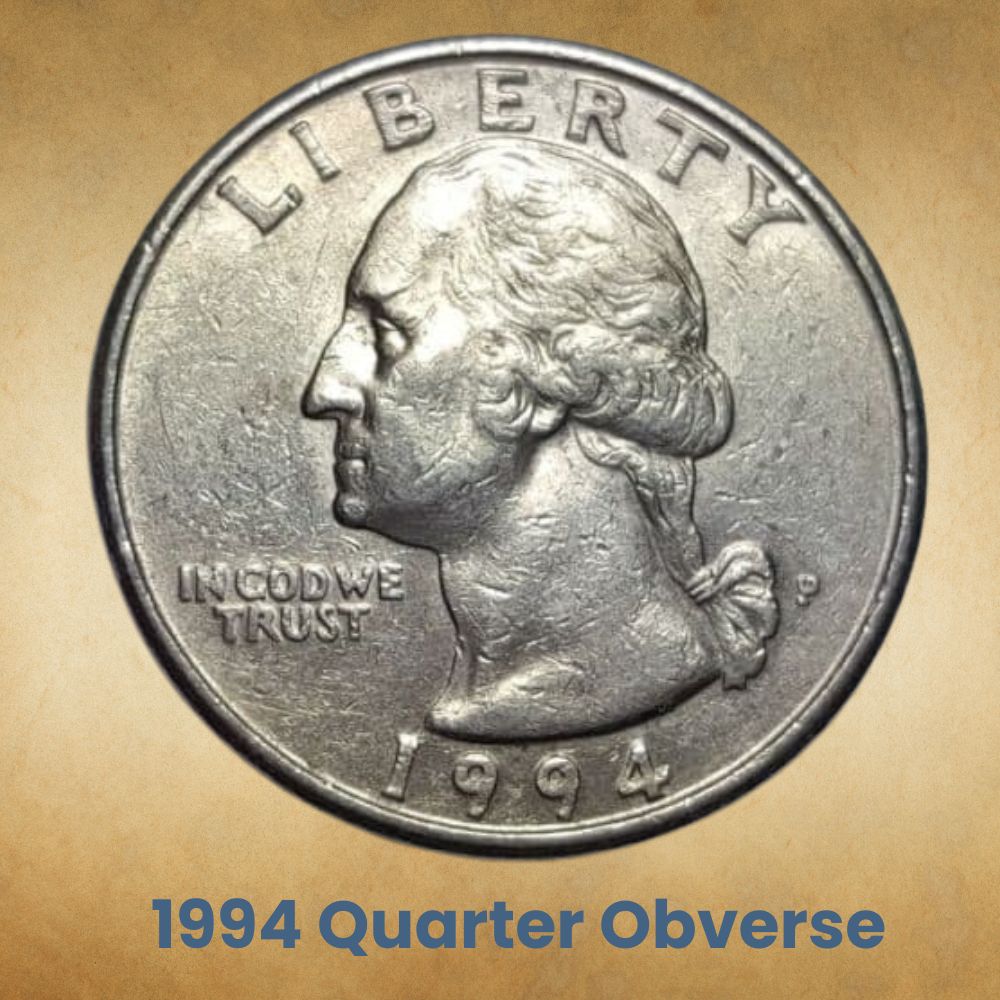
The obverse (heads side) of the 1994 Quarter shows a profile of George Washington facing left. The designer’s initials, JF for John Flanagan, are towards the right of the neckline cut-off. The mint mark is on the right, behind Washington’s ponytail. The legend Liberty is above his head and In God We Trust is on the lower left field. The mint date is at the coin’s bottom.
The Reverse of the 1994 Quarter
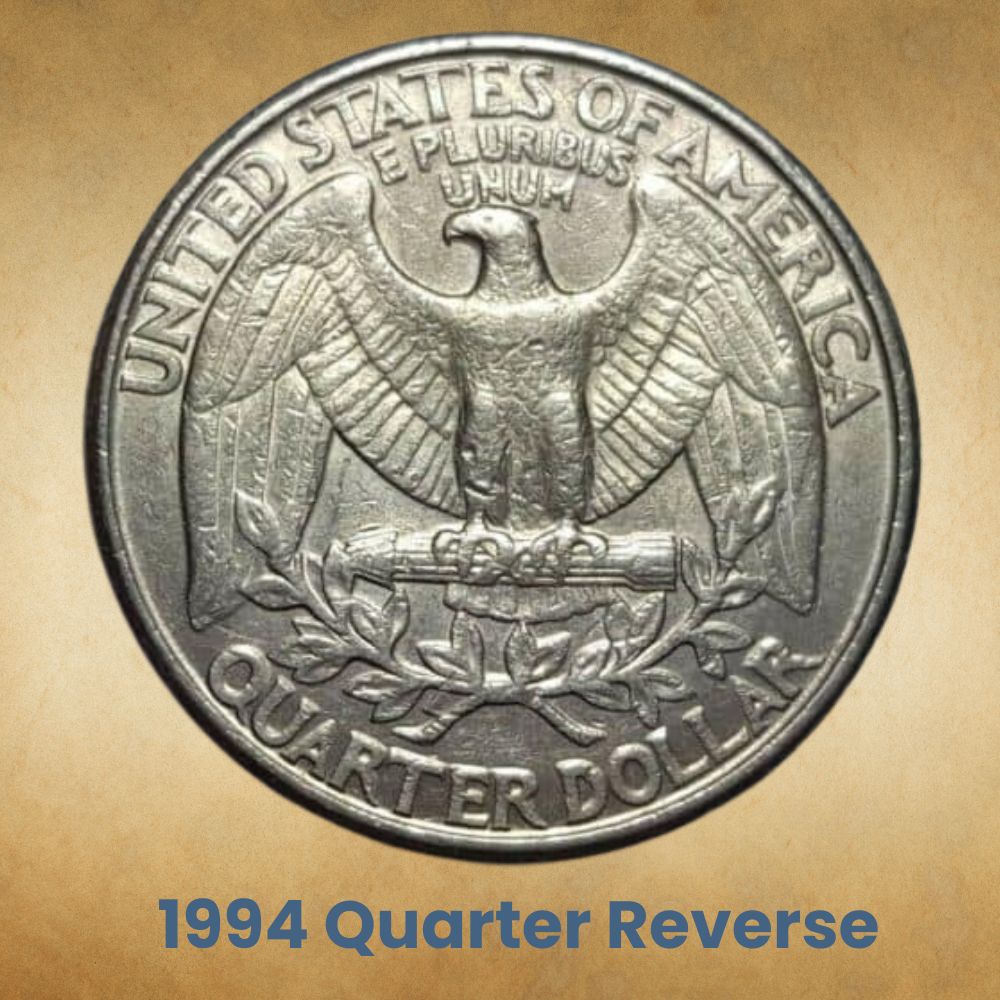
The reverse (tails side) of the 1994 Quarter has an eagle with its wings stretched out. It’s holding a bundle of arrows in its talons, and a pair of olive branches curve under its tail. The upper tips of the olive branches touch the eagle’s wings. The top of the coin reads United States of America followed by E Pluribus Unum. The coin’s bottom reads Quarter Dollar.
Other Features of the 1994 Quarter
The 1994 Quarter has two metal composition variants. The business strikes are 91.67% copper and 8.33% nickel. Some proofs have this same metal mix while others are 90% silver and 10% copper. But they’re all 24.3mm in diameter (0.955 inches) and 1.75mm thick (0.069 inches) with 119 reeds. The cupronickel-clad coins weigh 5.67g but the silver ones are 6.25g.
Related Posts: 20 Most Valuable State Quarters Worth Money
FAQs About the 1994 Quarter
How Much is a 1994 US Coin Worth?
The 1994 Quarter comes in four varieties excluding mint mistakes. Let’s look at the highest known grades for each variety. Some are PCGS price estimates since the coins have never sold, but all these rates accurate and reliable. In 2023, a 1994-P Graded MS 68 is $4,000 and a 1994-D Graded MS 67+ is $ 1,500. 1994 Proof Quarters are way cheaper. A 1994-S Clad Quarter Graded PR 70 DCAM is $40. A 1994-S Silver Quarter Graded PR 70 DCAM is $65.
Related Posts: 21 Most Valuable Quarters In Circulation
